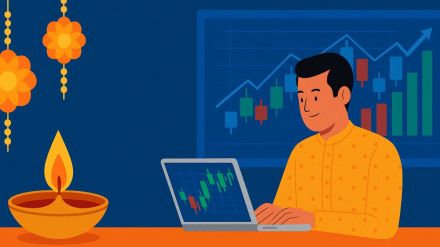As diyas light up your homes on Diwali day, Dalal Street too lights up with the glow of the trading screens. For one special hour, the stock market transforms into a sacred space where prosperity, belief, and business merge.
This annual ritual, famously known as the ‘Muhurat Trading’, for many Indian investors is more than just a symbolic session.
Let’s take a look at what is Muhurat Trading and how it has evolved over the time –
The origin: A ritual born from belief
The roots of Muhurat Trading traces to the early days of the Bombay Stock Exchange (BSE). This is long before the advent of terminals and algorithms.
In the 1950s and 1960s, on the BSE floor brokers would gather in traditional attire. There they would perform Lakshmi puja before making their first trades.
The belief was simple yet powerful. This, in a way was similar to how farmers sought blessings before sowing seeds. In a similar way, traders sought divine grace before sowing wealth.
The first trade made during the muhurat (auspicious time) was symbolic. It is believed this is a way to invite Goddess Lakshmi, the goddess of wealth, into their books.
The 1980s–1990s:Transition era for D’Street
By the 1980s, India’s markets were expanding. The excitement around the Muhurat session also began to gain ground.
It became an event – part ritual, part celebration. During this one hour, the BSE floor would be abuzz with sweets, diyas, and greetings as brokers exchanged mithai instead of data sheets.
Cut to the 1990s, with the introduction of electronic trading and the formation of the National Stock Exchange (NSE), Muhurat Trading took up a digital avatar.
The festive spirit still as high as ever, but trades were executed through terminals rather than open outcry as earlier.
What in the early phase began as a close-knit gathering had turned into a nationwide event, open to every retail investor with a trading account.
The 2000s: From puja to participation
The new millennium marked a cultural shift. In this period, investing was no longer restricted to brokers or business families. Retail investors began seeing the Muhurat hour as a symbolic opportunity.
During this period, buying even a single share of a trusted company became a Diwali tradition for many.
Even, most of the times, the markets too responded to this growing sentiment, ending the session on positive on Muhurat days.
The 2010s: What happens when sentiment meets screens
With online and mobile trading platforms gaining traction, Muhurat Trading went mainstream during this period.
With these changes, investors sitting miles away from Dalal Street could now participate with just a tap.
Brokerages began offering “Diwali Picks” and “Samvat Outlooks”. This guided investors on which stocks could shine in the year ahead.
The modern day: What changes when faith meets fintech
Let’s move fast forward to 2025, the scene looks very different. Now, the ringing bells are digital. The prayers are virtual and the trades are algorithmic.
Yet, what remains unchanged is the sentiment.
In an era of global markets and AI-led investing technique, Muhurat Trading reminds India that the market is not just about numbers. It is also about emotion, trust, and continuity.
